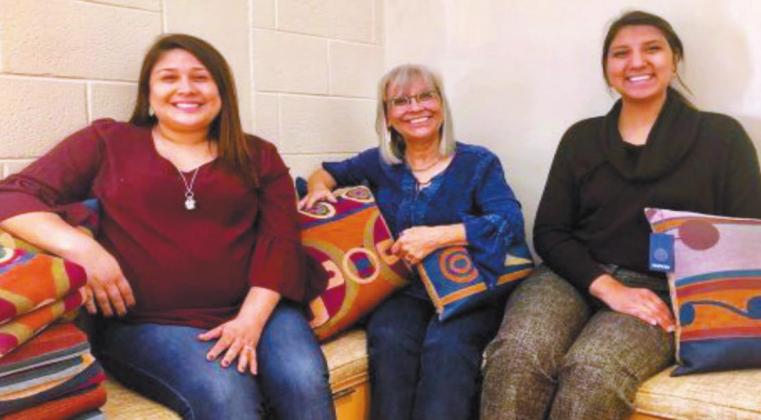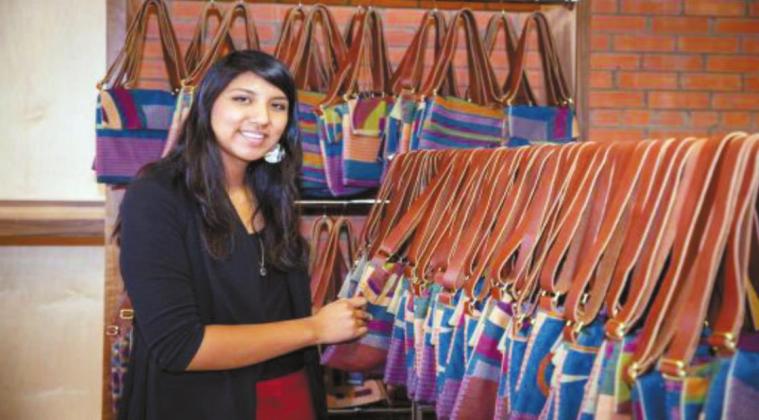SULPHUR, Okla. – A young Taloa Underwood would not have envisioned the place she now stands in the fashion and textile world. Designer, weaver, business woman, culture bearer – they were as far away as the moon.
In reality, her path to success was a stone’s throw away, in the presence of those closest to her growing up in Sulphur on her great-grandfather’s original Chickasaw allotment land. Relatives, friends and mentors saw what she could not. They knew her better than she knew herself, Underwood would say. They nurtured the success now in full bloom.
They are more than happy to vaunt Underwood’s successes to make up for her humble nature. What materializes from their words is a picture of a young Chickasaw willing to get her hands dirty with any art form while soaking up the wisdom of those around her.
“When Taloa was a child, she took dance lessons and would learn the steps so quickly. I was always amazed. Even now, she is still learning and trying different kinds of art and picking up things so quickly,” Joanna Underwood Blackburn, Taloa’s paternal aunt, remembered.
Underwood Blackburn is herself a famed Chickasaw artist specializing in sculpture and pottery. The two have been close all of Underwood’s life.
“She’s been helping me since she was a little girl. She’d usually help me pack and unpack and get my booth set up. Now she’s setting up for her own artwork and inspiring me,” Underwood Blackburn said Underwood credits her aunt with initiating her appreciation of art.
“Joanna was a big part of why I loved art. She would take me to art shows like Red Earth. I got to meet all of the customers and other artists,” Underwood said.
“It was nice to get perspectives on art from different people, a lot of painters and sculptors. I thought, ‘Wow, this is all really cool. Would I like to be a painter, to sculpt, would I like to do drawings?’”
Underwood also credits her mother, Tina Underwood, and grandparents, Juanita and Gene Underwood, with helping shape who she is today. They offered unconditional support.
Their impact came in many forms. Hands-on learning could be seen in moments like spending time together molding clay. They offered encouragement in times of doubt. They urged her to enroll in various programs the Chickasaw Nation offered, like the Chickasaw Arts Academy. Whenever possible, they prompted Underwood to compete in art shows. Despite her natural skill with art, Underwood did not intend to make a living with it. She wanted to help others. Nursing, veterinary services and social services were paths she contemplated. She focused on these selfless professions when attending Sulphur High School and East Central University (ECU) in Ada.
Things changed when her aunt introduced Underwood to renowned Chickasaw weaver and fashion designer Margaret Roach Wheeler.
“Hey, my friend Margaret is a textile weaver. She’d like to teach somebody how to weave. I was wondering if you’d be interested?” the aunt asked her niece four years ago.
Underwood was indeed interested.
A few days later, she sat at a table loom in the ARTesian Gallery & Studios working on her first scrub cloths and soap bags.
“Margaret saw I did a good job as a first time weaver, especially with the fiber I was working with. It was sticky and I was having a little bit of trouble, but I could work out the problems without needing help and it surprised her. So she asked if I wanted to try something on a bigger loom. I was so excited,” Underwood remembered.
Next, it was on to the floor loom, learning how to work a warp and tie up the loom.
“It was a whole new world to me. I had no idea this art medium existed,” Underwood said. “This wonderful person was teaching me everything she knew. I just fell in love with it. She was so excited to teach me. She even had me create my own patterns.”
Underwood continued to learn from and work with Wheeler while studying at ECU.
A professor of Native American studies at ECU, Thomas Cowger, was the next major influence on Underwood’s trajectory. After one class and a few prompts in the hallway, he convinced Underwood to take on Native American studies as a major.
“He loves tribal nations, learning about them, spreading awareness, helping the tribes,” Underwood said. “We weren’t just learning about our own tribes. We were studying tribes across the nation.”
Though there is still much to be uncovered in the area of study, Underwood began digging into historical Southeastern designs and symbols. Her studies at college and mentorship under Wheeler came together to reinforce Underwood’s work as a weaver.
“Margaret is wonderful because she has done her own research. She has binders full of stuff she’s found. I can go to her, and she’ll have some idea of what a symbol might mean,” Underwood said.
“What I really wanted to do was be able to research our culture and designs, anything I could help educate the public with.”
Soon, Underwood would complete her Bachelor of Arts degree – just in time to play a pivotal role in the development of an entire business.


